China will exploit new sailing routes to the Atlantic and threaten UK interests, warns First Sea Lord

The First Sea Lord has warned that China will exploit new sailing routes to the Atlantic that are being opened up as a result of melting polar ice caps.
In a speech on board the aircraft carrier HMS Prince of Wales Admiral Tony Radakin said the effects of climate change on the northern sea passage would create “new maritime trade routes across the top of the world” which would halve “the transit time between Europe and Asia”.
Admiral Radakin said: “When China sails its growing Navy into the Atlantic, which way will it come, the long route, or the short?”
He cautioned that the free movement of “nations, their navies, and above all their merchant ships” could be put at risk when China starts to use these routes as it would “threaten this concept” of free maritime movement.
“The world is getting more competitive, more contested,” he added. “We will have to play our role in that world. As the High North becomes more open and accessible it’s going to be more contested and competitive as well.”
Jeremy Quin, the Minister for Defence Procurement, added that “climate change is a reality, there is a real risk that it will open up seaways and we should expect that those seaways will be used”.
According to a Pentagon report on the People’s Liberation Army, released in September, Beijing has the world’s largest naval fleet with 350 ships and submarines.
Defence sources warned that the increasing size of China’s navy remained a concern as it was likely to become more active in the Atlantic which is deemed the UK’s “backyard”.
It is understood that defence chiefs fear a situation like the Strait of Hormuz could develop, which saw tensions flare in July last year after British Royal Marines helped seize an Iranian tanker near Gibraltar which was suspected of breaking EU sanctions.
In retaliation a British-flagged oil tanker was seized and anchored for two months after it was accused of allegedly breaking maritime rules.
Admiral Radakin also warned that the High North routes “skirt the coast of that resurgent Russia”.
“A Russia that is now more active in the Atlantic, our backyard, than it has been for over 30 years,” he said.
Last month the Royal Navy demonstrated to the Kremlin that it does not have freedom of the Arctic by leading a multi-national task group of warships and aircraft into the icy corridor:

In the first such operation for 20 years, Type-23 Frigate HMS Sutherland was been joined by American, Danish and Norwegian forces to demonstrate freedom of navigation above the Arctic Circle. Admiral Radakin added: “We are already doing much more in the High North.
“We will be looking in the ‘high’ High North, as we do in the Atlantic and elsewhere in the world, to join with our partners.”
Meanwhile he said that while space and cyber made the world more transparent, the one place left to hide remained “under the sea”.
He said that 97 per cent of data travels on undersea cables and that “our adversaries are already threatening these”. He said the Government was committed to “developing new capabilities to protect those cables, standing up to this threat on behalf of everyone”.


